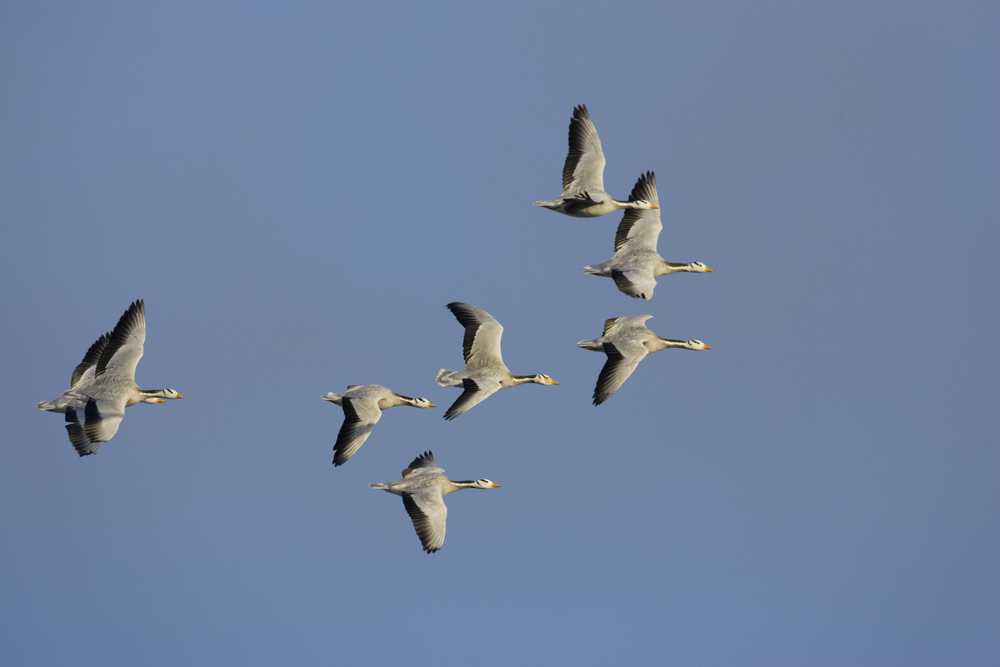How High Can Birds Fly?

The sight of an animal that can take to the air often inspires envy — and numerous forms of imitation — in humans.
This is especially true for the types of birds that exhibit extreme abilities, soaring to fantastic heights many thousands of feet above the ground, where the cold and lack of oxygen would challenge humans' ability to survive.
The highest flyer of all — Rüppell's griffon vulture, native to central Africa — was confirmed to cruise at 37,000 feet (11,278 meters) after one collided with an airplane at that altitude, as reported in 1974 in the journal The Wilson Bulletin.
Many bird species live in habitats that are over 13,123 feet (4,000 m) above sea level, and others routinely fly to altitudes of approximately 10,000 to 13,000 feet (3,000 to 4,000 m), especially when they're migrating, said Graham Scott, an assistant professor of biology at McMaster University in Ontario, Canada.
A number of bird species cruise at altitudes even higher than that, wrote Scott in a 2011 study published in the Journal of Experimental Biology. Scott studies how vertebrates — animals with backbones — perform in physically challenging environments.
According to Scott, birds as small as sparrows and hummingbirds in the Alpine region can be found at altitudes of 16,404 feet (5,000 m), while massive Andean condors glide on air currents at heights of 18,044 feet (5,500 m). Mallard ducks are known to reach altitudes of 21,000 feet (6,401 m), and Central Asia's bar-headed geese have been directly tracked at 23,917 feet (7,290 m). [Video: Secrets of the High-Flying Bar-Headed Goose]
Up, up and away
Somehow, these high flyers can exert themselves at exceptional altitudes. But what allows them to navigate the air up there? While these birds vary in size, they have one thing in common: a longer wingspan relative to their bodies, compared with birds that fly lower.
Get the world’s most fascinating discoveries delivered straight to your inbox.
"That's something we consistently see," Scott said. "Longer wings are better for generating lift to keep the body aloft."
But it takes more than longer wings to navigate high altitudes, which come with enormous physical trials, Scott added.
"The first big challenge is that the air gets less dense," he said. "As they go higher, they have to flap harder to stay aloft, so their metabolic demands increase. The oxygen levels become more limited. At high altitudes, it gets colder, and they need to keep their bodies warm. And the air gets drier — they're more likely to lose water from breathing and evaporation, and be thirsty."
So what keeps these high fliers going? There are certainly physical adaptations that allow birds to reach exceptional heights, said Charles Bishop, a senior lecturer in zoology at the School of Biological Sciences at Bangor University in the United Kingdom.
Bishop, who studies high-flying bar-headed geese, told Live Science in an email that the geese do not appear to suffer from altitude sickness or from cerebral or pulmonary edema, "so that, unlike humans they do not feel ill when at high altitude."
The geese also hyperventilate to increase their oxygen intake while flying. This rapid breathing makes their blood more alkaline, a change that in humans affects circulation to the brain (which is why hyperventilating makes people feel dizzy or faint).
But geese are very tolerant of high pH (alkaline conditions), Bishop explained, so blood flow to the animals' brains and bodies remains healthy.
"Finally, the hemoglobin in their blood has quite a high affinity for oxygen binding," Bishop told Live Science. "Again, this maximizes oxygen uptake." [Quest for Survival: Photos of Incredible Animal Migrations]
"A roller-coaster strategy"
And part of the birds' secret could simply be not staying up high for too long.
According to Bishop, bar-headed geese use "a roller-coaster strategy" during their long migrations, which can span 1,243 to 3,107 miles (2,000 to 5,000 kilometers), covered in flight periods that last from 5 to 200 hours.
"As they cross the Tibetan-Qinghai Plateau, the birds typically range in altitude from 4,000 m [16,404 feet] to 5,500 m [18,044 feet], with the odd excursion to just over 6,000 m [19,685 feet]," Bishop said.
In fact, he added, 98 percent of the direct observations of the geese's altitude occurred below 18,044 feet (5,500 m).
"Whenever the geese had to travel over a high obstacle, they would come down immediately afterwards," Bishop said.
And flying higher may actually provide birds with better conditions for long hauls, Scott suggested. Migratory flights at higher altitudes mean exposure to fewer predators, while tail winds can help the birds fly with less effort and cooler temperatures may keep the animals from overheating, he added.
Original article on Live Science.

Mindy Weisberger is a science journalist and author of "Rise of the Zombie Bugs: The Surprising Science of Parasitic Mind-Control" (Hopkins Press). She formerly edited for Scholastic and was a channel editor and senior writer for Live Science. She has reported on general science, covering climate change, paleontology, biology and space. Mindy studied film at Columbia University; prior to LS, she produced, wrote and directed media for the American Museum of Natural History in NYC. Her videos about dinosaurs, astrophysics, biodiversity and evolution appear in museums and science centers worldwide, earning awards such as the CINE Golden Eagle and the Communicator Award of Excellence. Her writing has also appeared in Scientific American, The Washington Post, How It Works Magazine and CNN.



